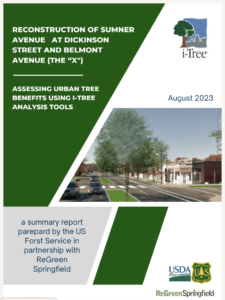 The reconstruction of urban infrastructure often presents opportunities to enhance the sustainability and livability of communities through the integration of green infrastructure.
The reconstruction of urban infrastructure often presents opportunities to enhance the sustainability and livability of communities through the integration of green infrastructure.
One such tool that aids in assessing the benefits of trees in urban settings is the i-Tree Planting software. A report was just completed by the US Forest Service, in partnership with ReGreen Springfield, that outlines how i-Tree Planting software was employed to calculate the benefits of existing, proposed, and trees that are being removed as part of the reconstruction of Sumner Avenue at Dickinson Street and Belmont Avenue(referred to as “The X”) in Springfield, MA.
The i-Tree Planting software analyzed the existing tree canopy cover along Sumner Avenue, evaluating their contributions to air quality improvement, stormwater runoff reduction, energy savings, and carbon sequestration. The results highlighted the significant role that the existing trees played in mitigating the urban heat island effect and enhancing local air quality.
Over the span of a decade, they are projected to collectively sequester 69,106.2 pounds of CO2, continue the legacy of ozone removal by eliminating 232.43 pounds, and extract 9.0 pounds of sulfur dioxide and 8.01 pounds of particulate matter 2.5 from the air.
Furthermore, these new trees possess the potential to intercept a substantial 470,331.7 gallons of rainfall, alleviating the burden on the soil, preventing erosion and lessening urban flooding. Their contributions extend to the avoidance of 84,923.1 gallons of runoff, as they participate in preserving the delicate balance of the local ecosystem.
In the end, these three scenarios underscore the indispensable role that trees play in maintaining environmental equilibrium, showcasing the cascading effects of their presence, absence, and revival.
Click Here to read the report brief.
